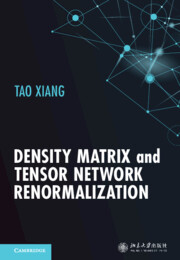
-
Select format
-
- Publisher:
- Cambridge University Press
- Publication date:
- January 2024
- August 2023
- ISBN:
- 9781009398671
- 9781009398701
- Dimensions:
- (250 x 176 mm)
- Weight & Pages:
- 0.94kg, 454 Pages
- Dimensions:
- Weight & Pages:
You may already have access via personal or institutional login
Book description
Renormalization group theory of tensor network states provides a powerful tool for studying quantum many-body problems and a new paradigm for understanding entangled structures of complex systems. In recent decades the theory has rapidly evolved into a universal framework and language employed by researchers in fields ranging from condensed matter theory to machine learning. This book presents a pedagogical and comprehensive introduction to this field for the first time. After an introductory survey on the major advances in tensor network algorithms and their applications, it introduces step-by-step the tensor network representations of quantum states and the tensor-network renormalization group methods developed over the past three decades. Basic statistical and condensed matter physics models are used to demonstrate how the tensor network renormalization works. An accessible primer for scientists and engineers, this book would also be ideal as a reference text for a graduate course in this area.
Reviews
‘This is the comprehensive textbook the research community on tensor network has been anticipating. Student readers can quickly get used to standard formulations and pictorial diagrams without much effort. Even an expert in this field can capture the current frontiers and can refresh the fundamental concepts. I learned something new every time I read a paragraph.’
Tomotoshi Nishino - Kobe University
‘The author steers the reader expertly through sometimes complex methods, explaining why each is introduced, rather than simply presenting recipes, and choosing physical examples to provide guidance through the technical material.’
Bruce Normand - Paul Scherrer Institute
‘This authoritative introduction will become an invaluable resource for newcomers and experts alike. A very welcome feature is the use of a unified set of notational and diagrammatic conventions, employed consistently throughout the text. This greatly aids the reader in recognizing recurring strategies and ideas.’
Jan von Delft - Ludwig-Maximilians-University Munich
Contents
Metrics
Altmetric attention score
Full text views
Full text views help Loading metrics...
Loading metrics...
* Views captured on Cambridge Core between #date#. This data will be updated every 24 hours.
Usage data cannot currently be displayed.
Accessibility standard: Unknown
Accessibility compliance for the PDF of this book is currently unknown and may be updated in the future.


